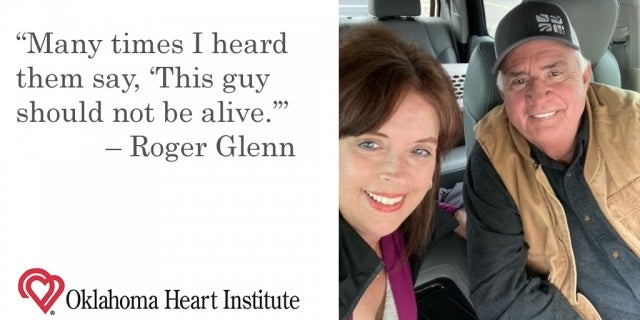For Roger Glenn, a 69-year-old living in Grove, Oklahoma, with his wife and son, the day started normal enough.
He woke early and decided to sit and read until getting ready for his current vocation: driving a public school bus. But as he was walking to his recliner, he felt a severe pain – first in his groin and then in his chest - like something was sitting on him.
“The pain was terrible,” Glenn said. “I called out to my wife and told her I needed to go to the emergency room, but as she was getting ready, the pain got worse and I was scared about what was going on. So I called the EMTs at the local fire department.”
Helicopter ride to Tulsa
The EMTs arrived quickly, but Glenn started blacking out for short periods as his blood pressure dropped dangerously low. With this development and other strange readings, the decision was quickly made to send Glenn to Oklahoma Heart Institute in Tulsa by helicopter.
Once he arrived at the hospital, he was rushed in for tests and then into a procedure room.
“Mr. Glenn had an extremely large pulmonary embolism, due to complications from COVID-19 that caused the right side of his heart to start failing,” said Adam Betz, M.D., medical director of pulmonary ECMO (extracorporeal membrane oxygenation) at Oklahoma Heart Institute.
Betz added, “He needed a procedure to remove the clots, but his heart was struggling to work. With the help of ECMO, Mr. Glenn remained stable while we performed a less invasive procedure to suction the blood clots from his lungs.”
ECMO
The ECMO machine works by inserting a plastic tube into a large artery through the neck, chest or groin of the patient. This tube allows for the patient's blood to flow out into an oxygenator (artificial lung) while the physician performs the procedure. The machine does the work of the lungs, which is easier on the patient’s heart.
In addition, since the procedure is done through a major artery without chest surgery, the patient can be kept conscious, in order to monitor any breathing difficulties.
“When I came to, I was lying on an exam table in a cold room surrounded by monitors and lots of people,” Glenn said. “I asked the woman at the head of my bed, ‘What’s going on?’ She replied, ’You have several blood clots in your lungs that need to be removed.’”
Roger continued to lie there, drifting in and out of consciousness.
“I could turn my head,” he said, “and see the people at the end of the bed and the blood clots they were suctioning out of my body. More than once I heard them say, ‘This guy should not be alive,’ and I'm thinking, ‘God, this is my chance to go.’ I'm lying there crying, asking God to take me, but he didn’t want to let me go. God knows when I'm leaving and I know that he's got something else planned for me.”
Moving closer to family
Glenn said he believes he now has more time to settle his affairs, sell off some property and move to Norman, Oklahoma, to be closer to his wife’s parents. Helping him through all of this was the care he received at Oklahoma Heart Institute.
“The staff at OHI are irreplaceable,” he said. “All the doctors, nurses and caretakers who came in my room were just super. OHI has been there for me, to bring me through every time. They saved my life and I can’t say enough good things about them.”
When Glenn and his wife move to Norman after the school year, it may not be long before he is back on the bus.
“I've already checked with Norman Public Schools,” he said. “When I get down there, I may drive a school bus for them because I really enjoy it. So many of the students really need someone to say, ’Good morning‘ and ’Have a wonderful evening‘ to them every day. I just feel that this is an outreach that I need to do.”
For more information about ECMO, please visit oklahomaheart.com/ecmo.

